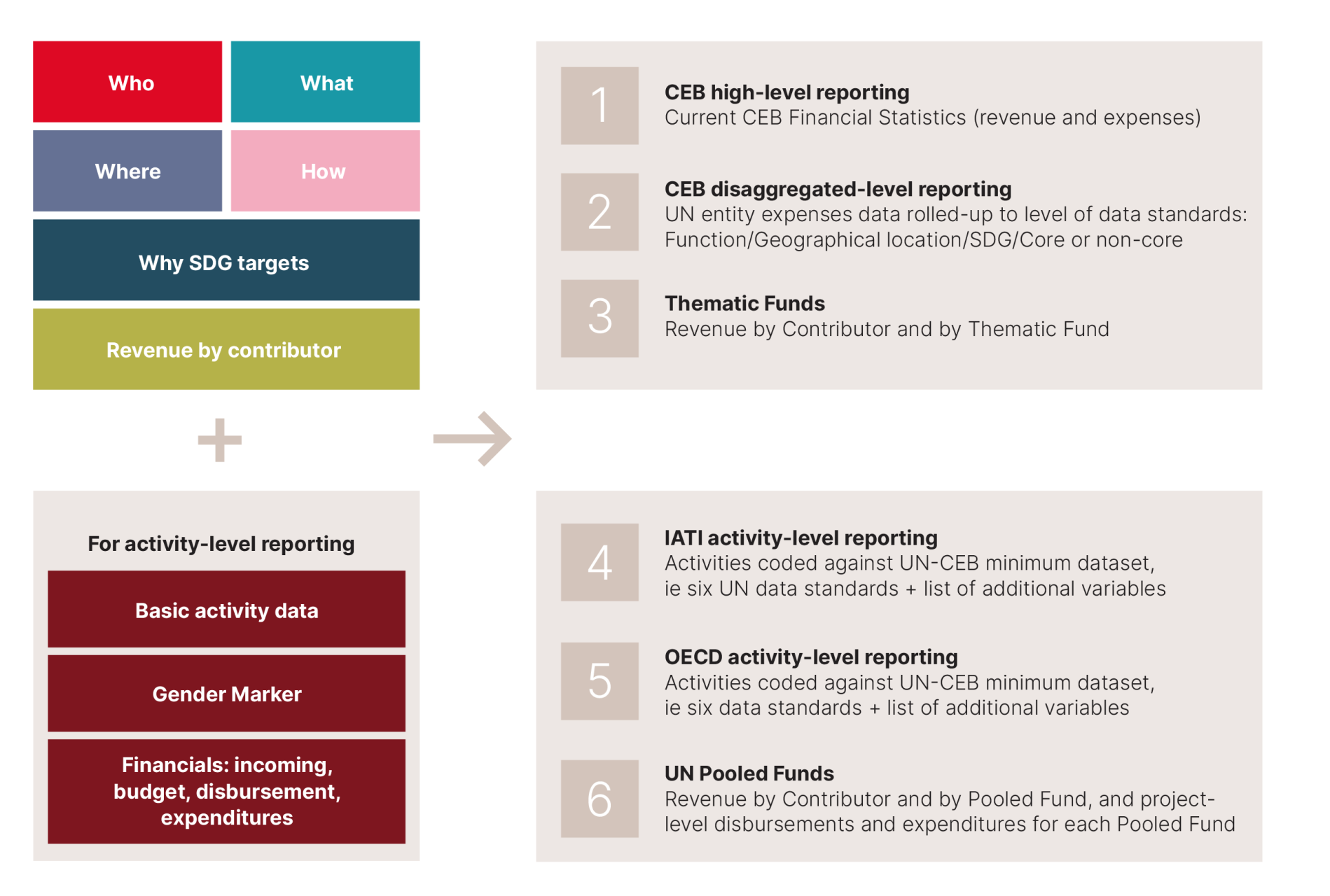Under the chairmanship of the United Nations Secretary-General, the Chief Executives Board (CEB) brings together the Executive Heads of the UN, its 12 funds and programmes, the 15 specialised agencies, and three related organisations. The CEB fosters a coherent approach to policy and management matters, enhancing UN system-wide coordination in support of intergovernmental mandates. The CEB is committed to supporting efforts of Member State and UN system organisations aimed at strengthening the multilateral system, and in making progress towards the achievement of the Sustainable Development Goals and the Pact for the Future. Through its High-Level Committee on Management (HLCM), the CEB strives to foster systemic transformation through, among other things, stronger performance and results orientation; better data, analysis and communications; and innovation and digital transformation.
Introduction
The Chief Executives Board (CEB) Secretariat is the UN inter-agency entity responsible for supporting the CEB’s work, and as such is the UN system’s highest-level coordination forum when it comes to programmatic, policy and management issues.
The CEB Secretariat collects and analyses annual UN system-wide financial and human resources data, which is published on the CEB website. The foundation of the financial data is the United Nations Data Standards for United Nations system-wide reporting of financial data.88 These Standards were developed through a UN Data Cube initiative, jointly through the CEB’s High-Level Committee on Management (HLCM) and the UN Sustainable Develop ment Group (UNSDG). The initiative’s long-term goals are to improve the quality of financial data reported to the CEB and ensure the UN system has timely, reliable, verifiable and comparable system-wide and entity-level financial data aligned with the Sustainable Development Goals (SDGs), in order to ‘make better decisions and deliver stronger support to those we serve’.
CEB member organisations

Source: Chief Executives Board (CEB).
The HLCM’s Finance and Budget Network approved a UN Data Cube strategy 2022–2025, and a core principle of the initiative is ‘maximising transparency and minimising effort’. The Strategy aims to provide UN stakeholders with a transparent, comprehensive snapshot of UN system-wide revenue and expenses, enabling better analytics and evidence-based decisions.89
Figure 40 illustrates the elements underpinning the strategy. The ultimate goal is to have UN entities develop a master dataset incorporating all the variables needed to produce the data necessary to report on each of the six data cuts shown on the right-hand side of the figure.
Elements underpinning the UN Data Cube strategy 2022–2025

Source: Chief Executives Board (CEB).
Future of the Data Cube strategy 2022–2025
The Data Cube strategy 2022–2025 reflects a strategic, forward-looking perspective on UN system-wide financial reporting. The CEB Secretariat, together with UN system organisations, will consider the future strategic direction of UN system financial data — either by extending the period of the existing strategy, or evolving it into a different strategy.
Decisions on the Data Cube Strategy going forward need to balance the needs of various stakeholders, such as data reporters, users and partners. It also needs to take into account the current financial context within which UN organisations are operating.
Preliminary 2024 Official development assistance (ODA) numbers, combined with projections for 2025 and 2026 point to significant drops in ODA between 2023 and 2025.90 As indicated in the report, total ODA in 2024 fell by 7.1% in real terms compared to 2023, marking the first drop after five years of consecutive growth. Looking ahead, the Organisation for Economic Co-operation and Development (OECD) notes that recent announcements by some Development Assistance Committee (DAC) members have raised concerns about future levels of ODA, and the OECD is examining the implications of such cuts.
Simulations developed by OECD show that ODA is estimated to drop between 9% and 17% from 2024 to 2025, depending on various scenarios that estimate the extent of the cuts. This will have flow on effects to the funding and capacities of UN system organisations.
Specifically related to UN system revenue, the CEB system-wide financial statistics show that revenue declined by US$ 7 billion or 9% in 2023. Preliminary data for 2024 shows a further decline of approximately 5%. High level projections for the system for 2025 and 2026, which are subject to change, reflect a reduction in revenue of greater than 25% from the peak of 2022, and many organisations expect this to worsen in 2026 and beyond.
The financial challenges that UN organisations are facing are not limited to one or two donors. Across the board, the UN system is anticipating or already experiencing declining contributions from key donors — even those that have traditionally been steadfast contributors to the UN.
In light of this, what will the CEB be taking into account when updating the Data Cube Strategy?
Current data cube strategy 2022-2025
- Overall, the strategic objective of the current strategy remains fully relevant.
Monitoring progress
- The monitoring tool that was developed by the CEB Secretariat to measure and track progress of the Data Cube strategy’s implementation, has shown that there have been significant advances made in recent years towards comprehensive, quality reporting by UN entities.
- Individual scorecards can be made available to reporting organisations to give feedback on their reporting and areas for improvement.
External environment:
- Data are used by many stakeholders for analysis and input into decision-making.
- The Quadrennial comprehensive policy review (QCPR) and 2024 Funding Compact indicators have already been incorporated into CEB’s 2024 financial data reporting: quality data on Enabling Functions; voluntary reporting on softly earmarked contributions; additional data on the Gender Equality Marker.
- Continued/new demands for ‘transparency’ – as reflected in conditions that donors are seeking to attach to funding agreements.
- SDGs until 2030 and the Pact for the Future.
Internal environment
- Capacity constraints both at the UN entity and UN system-wide level. Sufficient human and financial resource capacity is required within the CEB Secretariat to provide the necessary strategic leadership and technical support for development and implementation of the strategy.
- Trying to better understand the reporting requirements of UN system organisations, in recognition of the reporting burden.
- Communication with internal stakeholders.
Accessibility of data
- The CEB Secretariat has continued to enhance the CEB website’s functionality as the central place for Member States and other data users to find UN system-wide financial data. Disaggregated data on funding flows at entity and system-wide level can be accessed on the CEB website, including visualisations and the option of downloading.
Maintaining partnerships
- The CEB Secretariat continues to foster strategic partnership opportunities with the Organisation for Economic Cooperation and Development (OECD), the International Forum for Total Official Support to Sustainable Development (TOSSD), the International Aid Transparency Initiative (IATI) and the UN Multi-Partner Trust Fund Office (MPTFO). These partnerships assist with efforts to maximise the transparency of UN system financial data, with the ultimate aim of ensuring quality UN system-wide financial data is available to users on both the CEB website and other data platforms.
A final question that comes into consideration is, now that the UN-system financial data has improved so significantly over recent years, how can the UN system maximise the value of the comprehensive data that is available? In addition, how can UN system financial data be better used to enable more informed, data-driven decision making?
One example is a review completed in 2024 of the resources of the United Nations Security Management System (UNSMS). The HLCM’s Finance and Budget Network and the UN Department of Security Services (UNDSS) collaborated in carrying out a holistic review of the UNSMS resources. The review covered sources of funding, uses of funding and footprint over the period from 2018 to 2022.91
The results of the data collection part of the UNSMS Resources Review were analysed in a changing context set by trends in security risks, UN system revenue and expenses, and the overall UNSMS footprint.
The data analysis utilised CEB system-wide financial data, resulting in the development of several scenarios and options to stimulate thinking about possible courses of action related to funding of the UN’s jointly financed security resources. This is an example of how the UN system and its stakeholders can use the comprehensive data already available and combine with other data sets to enable more informed, data-driven decision making.
As the UN development system evolves to meet increa-singly complex global challenges, the future strategic discussions around the Data Cube strategy must prioritise usability, accessibility, and relevance.
Enhancing the quality and availability of financial data - while keeping the UN’s stakeholders in mind - is essential to support evidence-based decision-making, foster greater transparency, and enable more strategic allocation of resources across the UN system.